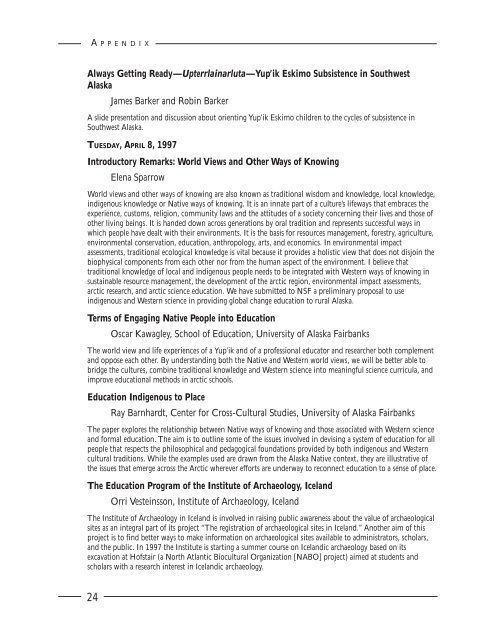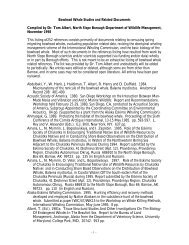ed report 4 page cover - Arctic Research Consortium of the United ...
ed report 4 page cover - Arctic Research Consortium of the United ...
ed report 4 page cover - Arctic Research Consortium of the United ...
Create successful ePaper yourself
Turn your PDF publications into a flip-book with our unique Google optimized e-Paper software.
A P P E N D I X<br />
Always Getting Ready—Upterrlainarluta—Yup’ik Eskimo Subsistence in Southwest<br />
Alaska<br />
James Barker and Robin Barker<br />
A slide presentation and discussion about orienting Yup’ik Eskimo children to <strong>the</strong> cycles <strong>of</strong> subsistence in<br />
Southwest Alaska.<br />
TUESDAY, APRIL 8, 1997<br />
Introductory Remarks: World Views and O<strong>the</strong>r Ways <strong>of</strong> Knowing<br />
Elena Sparrow<br />
World views and o<strong>the</strong>r ways <strong>of</strong> knowing are also known as traditional wisdom and knowl<strong>ed</strong>ge, local knowl<strong>ed</strong>ge,<br />
indigenous knowl<strong>ed</strong>ge or Native ways <strong>of</strong> knowing. It is an innate part <strong>of</strong> a culture’s lifeways that embraces <strong>the</strong><br />
experience, customs, religion, community laws and <strong>the</strong> attitudes <strong>of</strong> a society concerning <strong>the</strong>ir lives and those <strong>of</strong><br />
o<strong>the</strong>r living beings. It is hand<strong>ed</strong> down across generations by oral tradition and represents successful ways in<br />
which people have dealt with <strong>the</strong>ir environments. It is <strong>the</strong> basis for resources management, forestry, agriculture,<br />
environmental conservation, <strong>ed</strong>ucation, anthropology, arts, and economics. In environmental impact<br />
assessments, traditional ecological knowl<strong>ed</strong>ge is vital because it provides a holistic view that does not disjoin <strong>the</strong><br />
biophysical components from each o<strong>the</strong>r nor from <strong>the</strong> human aspect <strong>of</strong> <strong>the</strong> environment. I believe that<br />
traditional knowl<strong>ed</strong>ge <strong>of</strong> local and indigenous people ne<strong>ed</strong>s to be integrat<strong>ed</strong> with Western ways <strong>of</strong> knowing in<br />
sustainable resource management, <strong>the</strong> development <strong>of</strong> <strong>the</strong> arctic region, environmental impact assessments,<br />
arctic research, and arctic science <strong>ed</strong>ucation. We have submitt<strong>ed</strong> to NSF a preliminary proposal to use<br />
indigenous and Western science in providing global change <strong>ed</strong>ucation to rural Alaska.<br />
Terms <strong>of</strong> Engaging Native People into Education<br />
Oscar Kawagley, School <strong>of</strong> Education, University <strong>of</strong> Alaska Fairbanks<br />
The world view and life experiences <strong>of</strong> a Yup’ik and <strong>of</strong> a pr<strong>of</strong>essional <strong>ed</strong>ucator and researcher both complement<br />
and oppose each o<strong>the</strong>r. By understanding both <strong>the</strong> Native and Western world views, we will be better able to<br />
bridge <strong>the</strong> cultures, combine traditional knowl<strong>ed</strong>ge and Western science into meaningful science curricula, and<br />
improve <strong>ed</strong>ucational methods in arctic schools.<br />
Education Indigenous to Place<br />
Ray Barnhardt, Center for Cross-Cultural Studies, University <strong>of</strong> Alaska Fairbanks<br />
The paper explores <strong>the</strong> relationship between Native ways <strong>of</strong> knowing and those associat<strong>ed</strong> with Western science<br />
and formal <strong>ed</strong>ucation. The aim is to outline some <strong>of</strong> <strong>the</strong> issues involv<strong>ed</strong> in devising a system <strong>of</strong> <strong>ed</strong>ucation for all<br />
people that respects <strong>the</strong> philosophical and p<strong>ed</strong>agogical foundations provid<strong>ed</strong> by both indigenous and Western<br />
cultural traditions. While <strong>the</strong> examples us<strong>ed</strong> are drawn from <strong>the</strong> Alaska Native context, <strong>the</strong>y are illustrative <strong>of</strong><br />
<strong>the</strong> issues that emerge across <strong>the</strong> <strong>Arctic</strong> wherever efforts are underway to reconnect <strong>ed</strong>ucation to a sense <strong>of</strong> place.<br />
The Education Program <strong>of</strong> <strong>the</strong> Institute <strong>of</strong> Archaeology, Iceland<br />
Orri Vesteinsson, Institute <strong>of</strong> Archaeology, Iceland<br />
The Institute <strong>of</strong> Archaeology in Iceland is involv<strong>ed</strong> in raising public awareness about <strong>the</strong> value <strong>of</strong> archaeological<br />
sites as an integral part <strong>of</strong> its project “The registration <strong>of</strong> archaeological sites in Iceland.” Ano<strong>the</strong>r aim <strong>of</strong> this<br />
project is to find better ways to make information on archaeological sites available to administrators, scholars,<br />
and <strong>the</strong> public. In 1997 <strong>the</strong> Institute is starting a summer course on Icelandic archaeology bas<strong>ed</strong> on its<br />
excavation at H<strong>of</strong>stair (a North Atlantic Biocultural Organization [NABO] project) aim<strong>ed</strong> at students and<br />
scholars with a research interest in Icelandic archaeology.<br />
24




